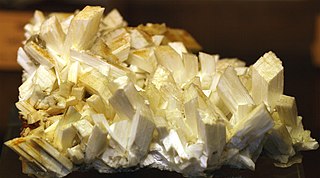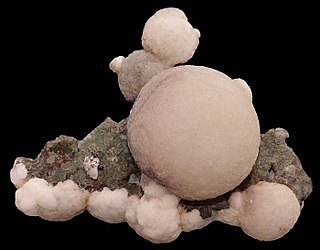
Celestine (the IMA-accepted name) or celestite is a mineral consisting of strontium sulfate (SrSO4). The mineral is named for its occasional delicate blue color. Celestine and the carbonate mineral strontianite are the principal sources of the element strontium, commonly used in fireworks and in various metal alloys.

Strontianite (SrCO3) is an important raw material for the extraction of strontium. It is a rare carbonate mineral and one of only a few strontium minerals. It is a member of the aragonite group.

Stilbite is the name of a series of tectosilicate minerals of the zeolite group. Prior to 1997, stilbite was recognized as a mineral species, but a reclassification in 1997 by the International Mineralogical Association changed it to a series name, with the mineral species being named:

Chabazite is a tectosilicate mineral of the zeolite group, closely related to gmelinite, with the chemical formula (Ca,K
2,Na
2,Mg)Al
2Si
4O
12•6H
2O. Recognized varieties include Chabazite-Ca, Chabazite-K, Chabazite-Na, and Chabazite-Sr, depending on the prominence of the indicated cation.

Natrolite is a tectosilicate mineral species belonging to the zeolite group. It is a hydrated sodium and aluminium silicate with the formula Na2Al2Si3O10·2H2O. The type locality is Hohentwiel, Hegau, Germany.

Scolecite is a tectosilicate mineral belonging to the zeolite group; it is a hydrated calcium silicate, CaAl2Si3O10·3H2O. Only minor amounts of sodium and traces of potassium substitute for calcium. There is an absence of barium, strontium, iron and magnesium. Scolecite is isostructural (having the same structure) with the sodium-calcium zeolite mesolite and the sodium zeolite natrolite, but it does not form a continuous chemical series with either of them. It was described in 1813, and named from the Greek word, σκώληξ (sko-lecks) = "worm" because of its reaction to the blowpipe flame.

Heulandite is the name of a series of tecto-silicate minerals of the zeolite group. Prior to 1997, heulandite was recognized as a mineral species, but a reclassification in 1997 by the International Mineralogical Association changed it to a series name, with the mineral species being named:

Gmelinite-Na is one of the rarer zeolites but the most common member of the gmelinite series, gmelinite-Ca, gmelinite-K and gmelinite-Na. It is closely related to the very similar mineral chabazite. Gmelinite was named as a single species in 1825 after Christian Gottlob Gmelin (1792–1860) professor of chemistry and mineralogist from Tübingen, Germany, and in 1997 it was raised to the status of a series.
Gmelinite-Na has been synthesised from Na-bearing aluminosilicate gels. The naturally occurring mineral forms striking crystals, shallow, six sided double pyramids, which can be colorless, white, pale yellow, greenish, orange, pink, and red. They have been compared to an angular flying saucer.

Harmotome is a mineral, one of the rarer zeolites; a hydrated barium silicate with formula: (Ba0.5,Ca0.5,Na,K)5Al5,Si11O32·12(H2O). It forms vitreous white well defined monoclinic crystals, often associated with calcite and other zeolites. It has a Mohs hardness of 4 to 5 and a specific gravity of 2.44 to 2.5.

Laumontite is a mineral, one of the zeolite group. Its molecular formula is Ca(AlSi2O6)2 · 4H2O, a hydrated calcium-aluminium silicate. Potassium or sodium may substitute for the calcium but only in very small amounts.

Thomsonite is the name of a series of tecto-silicate minerals of the zeolite group. Prior to 1997, thomsonite was recognized as a mineral species, but a reclassification in 1997 by the International Mineralogical Association changed it to a series name, with the mineral species being named thomsonite-Ca and thomsonite-Sr. Thomsonite-Ca, by far the more common of the two, is a hydrous sodium, calcium and aluminium silicate, NaCa2Al5Si5O20·6H2O. Strontium can substitute for the calcium and the appropriate species name depends on the dominant element. The species are visually indistinguishable and the series name thomsonite is used whenever testing has not been performed. Globally, thomsonite is one of the rarer zeolites.

Clinoptilolite is a natural zeolite composed of a microporous arrangement of silica and alumina tetrahedra. It has the complex formula (Na,K,Ca)
2–3Al
3(Al,Si)
2Si
13O
36•12H
2O. It forms as white, green to reddish tabular monoclinic tectosilicate crystals with a Mohs hardness of 3.5 to 4 and a specific gravity of 2.1 to 2.2. It commonly occurs as a devitrification product of volcanic glass shards in tuff and as vesicle fillings in basalts, andesites and rhyolites. It was described in 1969 from an occurrence in the Barstow Formation, San Bernardino County, California. Sodium levels in clinoptilolite are generally higher than potassium levels, as is the case with the San Bernardino Barstow Formation, but there are sources that are potassium-rich and have minimal sodium.

Edingtonite is a white, gray, brown, colorless, pink or yellow zeolite mineral. Its chemical formula is BaAl2Si3O10·4H2O. It has varieties with tetragonal, orthorhombic or triclinic crystals.
Partheite or parthéite is a calcium aluminium silicate and a member of the zeolite group of minerals, a group of silicates with large open channels throughout the crystal structure, which allow passage of liquids and gasses through the mineral. It was first discovered in 1979 in rodingitic dikes in an ophiolite zone of the Taurus Mountains in southwest Turkey. The second discovery occurred in gabbro-pegmatites in the Ural Mountains, Russia. Since its discovery and naming, the chemical formula for partheite has been revised from CaAl2Si2O8•2H2O to include not only water but hydroxyl groups as well. The framework of the mineral is interrupted due to these hydroxyl groups attaching themselves to aluminum centered oxygen tetrahedra. This type of interrupted framework is known in only one other zeolite, the mineral roggianite. As a silicate based mineral with the properties of a zeolite, partheite was first described as zeolite-like in 1984 and listed as a zeolite in 1985. Partheite and lawsonite are polymorphs. Associated minerals include prehnite, thomsonite, augite, chlorite and tremolite.
Paulingite or paulingite-K is a rare zeolite mineral that is found in vesicles in the basaltic rocks from the Columbia River near Rock Island Dam, Washington.
Cleusonite is a member of the crichtonite group of minerals with the chemical formula (Pb,Sr)(U4+
,U6+
)(Fe2+
,Zn)
2(Ti,Fe2+
,Fe3+
)
18(O,OH)
38. This group of minerals contains approximately thirteen complex metal titanates. The structures of minerals of this group is complicated by frequent fine-scale twinning and metamictization due to radioactive elements. The crichtonite group consists of members of related mineral species of the type A{BC2D6E12}O38 which are characterized by their predominant cations (as seen in crichtonite (Sr), senaite (Pb), davidite (REE + U), landauite (Na), loveringite (Ca), lindsleyite (Ba), and mathiasite (K).

Gonnardite is a comparatively rare, fibrous zeolite, natrolite subgroup. Older papers claim that a complete solid solution exists between tetranatrolite and gonnardite, but tetranatrolite was discredited as a separate species in 1999. A series, based on the disorder of the silicon-aluminum in the framework, appears to exist between Na-rich gonnardite and natrolite, Na2(Si3Al2)O10·2H2O.

Stellerite is a rare mineral discovered by and named after Georg Wilhelm Steller, a German explorer and zoologist. The mineral has a general formula of Ca[Al2Si7O18]·7H2O. Like most rare minerals, there are few commercial uses for stellerite. Mineral collectors are lucky to find it in good enough crystal form. Zeolites, including stellerite, have been studied using a dehydration process to gauge the potential use of their phases as molecular sieves, sorbents, and catalysts.

Collinsite is a mineral with chemical formula Ca
2(Mg,Fe2+
)(PO
4)
2•2H
2O. It was discovered in British Columbia, Canada, and formally described in 1927. It was named in honor of William Henry Collins (1878–1937), director of the Geological Survey of Canada. There are three varieties of the mineral: magnesian collinsite, zincian collinsite, and strontian collinsite. The crystal structure consists of polyhedral chains linked by weak hydrogen bonds.

Garronite-Ca is a fairly rare silicate mineral, from the zeolite, which has been found in a few dozen locations in the world. It was first found in the Glenariff Valley, Garron Plateau, County Antrim, Northern Ireland, and in some locations in Iceland. The name comes from the town of Garron, in Northern Ireland, which is consequently considered its type locality. The name initially used was that of Garronite, without subfixes, but the discovery in 2015 of a garronite with dominant sodium instead of calcium in the position of interchangeable cations made it necessary to use subfixes, remaining as Garronite-Ca, to distinguish it from the new species, Garronite-Na.

















